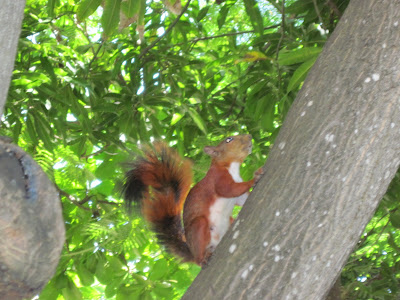Now nearly 100 years old, the Panama Canal was an extraordinary engineering achievement, although many lives were lost in its construction. How does it work? Simply stated, ships traveling between the Pacific and the Carribean (or vice versa) enter locks to raise them to higher water, then travel about 48 miles of waterways before being lowered through locks near the opposite coast. Here's what it looks like entering a lock.
The gates are opening.
The locks were built to accomodate large ships, by 1914 standards. The width of this lock is about 110 feet.
Plenty of room to spare, since this ship is only about 105.6 feet in width. Understandably, rail cars are used to tow ships through the locks, rather than expecting ships to stop, start and navigate a very narrow channel without doing much damage.
Here's a carge ship in an adjacent lock. Not much room to spare there. Work is underway to build wider locks for the future.
Looking back over closed gates.
Most traverse the Panama Canal between between the Carribean and the Pacific. Some follow a shorter route.
From the locks one can see the Bridge of the Americas, a main road through Panama.
A closer look at the bridge.
There's plenty of rugged Panamanian terrain.
One might imagine that the canal runs west-east between the Pacific and the Carribean. However, because of the way the Panama Isthmus curves, the journey is actually south-north. Here's another waterway view.
Soon it's lowering through more locks and on to the Carribean.
Ciao.





































